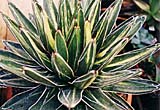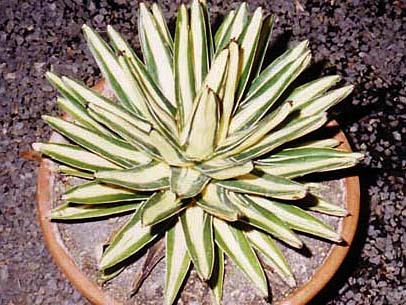The book list in RTF format (in German).
Jaromir Vavrouch, Revъckб 1214, CZ-784 01 Litovel, Tschechische Republik tel. 00420/585 342 291, e-mail: vavrouch@@volny.cz
I'm 51 and I started to collect cacti quite late in life- about 10 years ago, in 1996. Mainly because of this reason, I was buying plants that were mature and would flower sooner. I sow seeds very rarely, only for pleasure and out of curiosity. My advantage is my heated greenhouse (6x3 m) which I have built by myself. I started my collection quite unusually - with columnar cacti which I like a lot. Nowadays I own many 1 to 2 meters tall "columns" of genera Cereus, Trichocereus, Oreocereus, Lophocereus, Pilosocereus, Azureocereus, Cephalocereus, Neobuxbaumia, Rooksbya, Weberbauerocereus, Backebergia, Carnegiea, Cleistocactus, Espostoa, Eulychnia, Haageocereus, Harrisia, Lamaireocereus, Machaeocereus, Marginatocereus, Marshallocereus, Myrtillocactus, Neoraimondia, Pachycereus, Polaskia, Stetsonia, Vatricania and others. They dominate in the collection because of their size. Other cacti and succulents appeared in my collection with time and now it contains approximately 1,000 species of cacti and succulents.

After some initial period, I came to the point when I started to specialize in Agave genus from the Agavaceae family. Variation in color, form and size of rosettes and leaves impresses me greatly. Currently I own about 200 species and varieties of members of the genus, from one-meter rosettes to rare miniatures. Smaller plants reside in the greenhouse all the year round but bigger ones feel better outside, in open and sunny space and moved indoors in winter. Lately I put my energy in finding of variegated and miniature cultivars (mostly made in Japan) which are very rare and very expensive. The most valuable specimens of my collection is an spineless form of A. isthmensis and few different variegated forms of A. victoriae-reginae - f. variegata - medio-picta (I've never seen other specimen of the kind, even in Japanese books; probably it's the only existing plant, see the photo), f. variegata - marginata and f. variegata - striata.

I will mention my collection of cactus literature only briefly. I hope I will tell more about it someday. My library started in 1996 and nowadays it's the biggest and most valuable collection of literature on cacti and succulents in Czech Republic. It contains about 1,300 titles in different languages and few hundred volumes of magazines from around the world. The most valuable publications are the originals of C.F. Fцrster: Handbuch der Cacteenkunde (1846), T. Rьmpler: Fцrsterґs Handbuch der Cacteenkunde (1886), H. Allnutt: The Cactus and others Tropical Succulents (1877), K. Schumann: Gesamtbeschreibung der Kakteen (1899) and some others.
From all the magazines I would like to highlight the complete set of the journal of German society DKG (Deutsche Kakteengesellschaft) from the moment of origin under different names: Monatsschrift fьr Kakteenkunde (1891-1922), Zeitschrift fьr Sukkulentenkunde (1923-1928), Monatsschrift der DKG (1929-1932), Kakteenkunde (1933-1943), Der Kakteen-Freund (1932-1935), Jahrbuch der DKG (1935-1936), Kakteen und andere Sukkulenten (1937-1938), Cactaceae (1937-1944), Beitrдge zur Sukkulentenkunde und -pflege (1938-1943) and, finally, Kakteen und andere Sukkelenten ( from 1949 to nowadays). I should notice that search for old literature on cacti is very time and money consuming. Often it's a matter of luck. Regular replenishment of library with publications from around the world also presents great financial challenges.
Collecting of badges about cacti and other memorabilia became the main part of my hobby very soon. I started my collection in 1998 and now I own about 700 from different countries: 210 from Czechia and Czechoslovakia, 218 from Poland, 46 from Russia and the USSR, 5 from Ukraine, 35 from Belarus, 3 from Kazakhstan, 1 from Latvia, 2 from Azerbaijan, 4 from Hungary, 55 from Germany, 8 from Austria, 26 from Switzerland, 1 from Malta, 21 from Great Britain, 4 from Netherlands, 3 from Belgium, 1 from France, 1 from Nordisk Cactus Society (Denmark, Norway and Sweden), 2 from USA, 2 from Canada, 1 from Mexico, 1 from Argentina, 19 from Australia, 17 from New Zealand, 2 from India, 2 from Zimbabwe (including South Rhodesia) and 7 from unknown sources. Besides badges I have 39 medals (Czechia, Poland, Ukraine, Hungary, and Germany), 14 plaques (Czechia, Poland, Hungary, and Germany), 9 trinkets (Poland, Norway, Belgium), and 79 tiles (Czechia, Germany, Switzerland).
Few hundred of duplicates are available for exchange. In socialistic Czechoslovakia plenty of badges have been issued, but after 1990, because of financial difficulties, it happens only on exceptional occasions. I buy new badges if they are available, but in most of cases I exchange them by mail.
There are very few collectors of cacti badges in the world. I know only four people in Czechia. I have good contacts with Poland (2 collectors), Russia (1), Hungary (1), Germany (3), Great Britain (1), some collectors in Australia and that's it.
I keep my badges attached to special plates in boxes 40x30 cm. My pride in collection is hand-made badges of Russian artist A. M. Lopatin. I will be glad to make new contacts with other collectors for badges exchange.
I don't participate in exhibitions because of lack of security and, on other hand there are only five collectors of cacti badges in Czechia. That's why nobody has written about my collection in journals. I, myself, regularly write book reviews about cacti and succulents (mostly published in German) for Czech journal "Kaktusy".
I would be glad to make new contacts for exchange with other collectors who are interested in any of the subjects mentioned in this article.
Jaromir Vavrouch, Czechia





